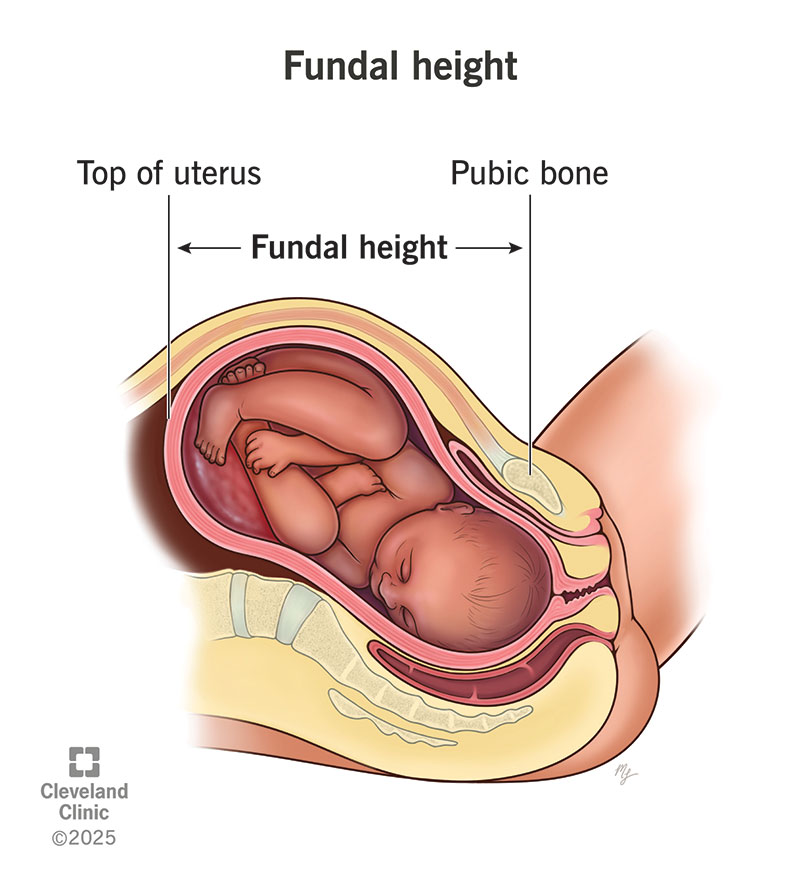Fundal height is the distance between the top of your uterus and your pubic bone. Healthcare providers use it to measure if fetal growth is on track. Fundal height is measured beginning about 20 weeks in pregnancy. If the fetus measures smaller or larger than average, you may need an ultrasound to get a more accurate size.
Advertisement
Cleveland Clinic is a non-profit academic medical center. Advertising on our site helps support our mission. We do not endorse non-Cleveland Clinic products or services. Policy

Fundal height is the distance between your pubic bone and the top of your uterus during pregnancy. Fundal height tells your pregnancy care provider important things about the fetus’s size, growth and position in your uterus. It can also help verify gestational age (a term to describe how far along the pregnancy is). Providers measure fundal height in centimeters using a measuring tape.
Advertisement
Cleveland Clinic is a non-profit academic medical center. Advertising on our site helps support our mission. We do not endorse non-Cleveland Clinic products or services. Policy
After about 20 weeks of pregnancy, your fundal height in centimeters should be close to how far you are in pregnancy. For example, if you’re 24 weeks pregnant, your fundal height should be around 24 centimeters.
Your provider measures fundal height at each prenatal appointment beginning at about 20 weeks of pregnancy. This is about the time when fundal height and gestational age begin to match each other.
Healthcare providers measure fundal height by locating your symphysis pubis and your fundus. Your symphysis pubis is a cartilage joint located between your pubic bones. The fundus is the top part of your uterus. They may press down and feel around to find it.
You don’t need to do anything before or after your provider measures fundal height. It’s a typical part of your prenatal check-up in the second and third trimesters.
The steps to calculate it are:
The location of your fundus moves as your pregnancy progresses. At about 12 weeks in pregnancy, your fundus is in almost the same spot as your pubic bone. By the time you reach 20 weeks, your fundus is at your belly button. This is about the time your fundal height and week of pregnancy begin to match one another.
Advertisement
At around 36 weeks, your fundus reaches your sternum (breastbone) (the highest point it will reach). After 36 weeks, your fundal height can decrease because the fetus drops into your pelvis to prepare for labor. Your provider may order additional tests to confirm that there aren’t other causes for the decrease in fundal height.
Fundal height is one of the simplest and least invasive ways to track fetal growth. It can be the first warning of growth problems or issues with fetal position.
Your pregnancy care provider will order an ultrasound if they’re concerned about fundal height. Ultrasounds are more accurate at predicting size but are only recommended two times during pregnancy (unless medically necessary).
Nothing is 100% accurate when it comes to estimating fetal size. It’s common for your sizing to be off by a centimeter or two. Your healthcare provider will do further testing if there’s a concern.
Your fundal height in centimeters should be close to the number of weeks you are in pregnancy, plus or minus 2 centimeters. For example, if you’re 32 weeks pregnant, a fundal height of 30 to 34 centimeters is an acceptable size.
But this is only the case from about weeks 20 to 36. Before 20 weeks of pregnancy, your fundus isn’t high enough. After 36 weeks of pregnancy, your fundus starts to go down.
Yes, fundal height can help indicate fetal size. In addition to measuring fundal height, your practitioner will feel your abdomen to get an idea of the fetus’s size and position in your uterus. It’s important to remember that fundal height is just an estimate. If fetal size is a concern at any point in your pregnancy, your healthcare provider will recommend further testing.
Your fundal height usually isn’t a reason for worry. It’s OK for it to be off by at least two weeks or 2 centimeters. Your healthcare provider will review your medical history and decide if you need further tests. It could simply be that your due date is wrong or the fetus is slightly smaller or larger than average.
Healthcare providers don’t use fundal height to measure your due date. Fundal height is used to track how big or small the fetus is compared to its gestational age.
Some reasons the fetus may measure ahead or large for gestational age are:
Sometimes, there isn’t a cause.
Some reasons why the fetus could be measuring small or behind for gestational age are:
Advertisement
If your healthcare provider is concerned about the fetus’s size, they may order an ultrasound or additional tests to take a closer look.
Measuring your fundal height is one way your healthcare provider can make sure the fetus’s growth is on track. If you’re told it’s measuring ahead or behind schedule, try not to worry. It usually just means an ultrasound or further testing is needed. Talk to your healthcare provider if you have any concerns about your fundal height.
Advertisement
Trying to choose where to give birth? Learn why Cleveland Clinic is the best choice to help you through each step of the labor and delivery process.

Last reviewed on 06/12/2025.
Learn more about the Health Library and our editorial process.